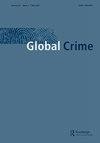Public mass shootings in developed countries: uncovering stability and change at the turn of the century
IF 1.9
Q2 CRIMINOLOGY & PENOLOGY
引用次数: 0
Abstract
ABSTRACTThis study examines the stability and change in public mass shootings in developed countries outside of the United States (2000–2021). Public mass shootings refer to incidents involving public/populated locations, random/symbolic victims, and at least four fatalities. Results identified an increase in the frequency of attacks in developed countries, although particularly deadly incidents remained relatively consistent. Offenders were commonly and consistently male, middle-aged, single, and diagnosed with a mental illness. Incidents often involved handguns, more than one firearm, and open-area locations. Offenders were often motivated by a desire for fame; although, early fame-seekers were younger, school shooters, while recent offenders had far-right ideological beliefs. Other changes included an increase in offenders obtaining their firearms illegally, using assault rifles, diversifying their target locations, and being shot and killed. This provides the first step for understanding mass shooting trends in the often-overlooked developed countries outside of the United States.KEYWORDS: Mass shootingsmass violence in developed countriesinternational homicide comparisonstrends in violence Disclosure statementNo potential conflict of interest was reported by the author.Notes1. Including Iceland, Norway, Switzerland, and the United Kingdom.2. In this study, mass shootings refer to public incidents that were completed. Public meaning they occurred in public or populated locations and at least some victims were chosen at random and/or for their symbolic value (Krouse & Richardson, Citation2015; Silva, Citation2022a). Completed meaning they involved four or more victim fatalities (Greene-Colozzi & Silva, Citation2022b; Silva, Citation2022c).3. Lankford (Citation2016a) found that despite making up less than 5% of the global population, the United States has produced 31% of global mass shootings.4. From this point forward, unless otherwise noted, all language referencing developed countries is excluding the United States.5. See Silva (Citation2022b) for an in-depth understanding of the nuanced data collection process used to identify cases.6. All variables – except for the motivation variables – are objective facts with no discretion in reporting (e.g. sex, age, etc.).7. In three cases it was unclear if the offender received prior mental health treatment. This was coded as no/no evidence.8. This study focused on mass shootings after the turn of the century to avoid issues with publicity effects and time-period effects impacting the ability to capture relevant cases using open-source data. Given the relatively small number of cases, the analysis only used two time period categories, each encompassing 11 years.9. Mental illness only included those with a clinical diagnosis – including 13 offenders who received treatment prior to the attack, and two who received treatment after the attack. However, five offenders had a suspected or likely mental illness (indicated by friends and family), and two offenders showed clear signs of mental illness prior to/during the attack, but they died during the attack, so this can never be fully confirmed. In other words, offenders suffering from mental health problems were likely higher than is currently captured in this study, which used a high threshold for operationalising mental illness.10. Although, it is important to emphasise that this study excluded family mass shootings, which only involve family members, and do not involve random or symbolic victims.11. Only one jihadist-inspired shooter was also fame-seeking. This indicates the previously suggested intersection of fame and ideology (Lankford & Silver, Citation2020; Silva, Citation2022b; Silva & Lankford, Citation2022) is largely associated with far-right extremist shooters in developed countries.12. This study excludes the 2014 Belgium shooting, as well as the January 2015 and November 2015 shootings in France. In line with the initial mass shooting definition, these three jihadist-inspired incidents were excluded because they involved organised terrorist groups or terrorist-sponsored violence (see also Silva, Citation2022b). Nonetheless, even if these incidents were included, they would still align with the current findings: they all occurred after 2010, in countries that are part of the European Union – primarily France.13. Only one shooter between 2000 and 2021 targeted their workplace, aligning with previous research finding workplace attacks were much less common in other developed countries than in the United States (Lankford, Citation2016a; Silva, Citation2022b).Additional informationFundingThis research was supported (in part) by funds from a Summer Stipend from the Research Center for the Arts, Humanities and Social Sciences at William Paterson University.Notes on contributorsJason R. SilvaJason R. Silva is an Assistant Professor in the Department of Sociology and Criminal Justice at William Paterson University. Silva’s research examines mass shootings, terrorism, school violence, and mass media. His recent publications have appeared in Justice Quarterly, International Journal of Comparative and Applied Criminal Justice, Homicide Studies, Aggression and Violent Behavior, and Journal of Interpersonal Violence.发达国家的公共大规模枪击事件:揭示世纪之交的稳定与变化
摘要本研究考察了2000-2021年美国以外发达国家公共大规模枪击事件的稳定性和变化。公共大规模枪击是指涉及公共/人口密集地点、随机/象征性受害者和至少4人死亡的事件。结果表明,发达国家的袭击频率有所增加,尽管特别致命的事件保持相对稳定。罪犯通常是男性,中年,单身,并被诊断患有精神疾病。事故通常涉及手枪、多支枪支以及露天场所。罪犯的动机往往是对名声的渴望;尽管早期的追名者是年轻的校园枪手,而最近的犯罪者则有极右翼的意识形态信仰。其他变化包括罪犯非法获得枪支、使用突击步枪、目标地点多样化以及被枪杀的人数增加。这为了解美国以外经常被忽视的发达国家的大规模枪击趋势提供了第一步。关键词:大规模枪击;发达国家大规模暴力;国际凶杀比较;暴力趋势;包括冰岛、挪威、瑞士和英国。在本研究中,大规模枪击事件是指已经完成的公共事件。公开意味着它们发生在公共或人口密集的地点,至少有一些受害者是随机选择的和/或具有象征意义(Krouse & Richardson, Citation2015;席尔瓦,Citation2022a)。完成意味着涉及四名或更多受害者死亡(green - colozzi & Silva, Citation2022b;席尔瓦Citation2022c)。3。兰克福德(Citation2016a)发现,尽管美国人口不到全球人口的5%,但美国制造了全球31%的大规模枪击事件。从现在起,除非另有说明,所有提及发达国家的语言都不包括美国。参见Silva (Citation2022b),深入了解用于识别病例的细微数据收集过程。除动机变量外,所有变量都是客观事实,在报告中没有酌情权(如性别、年龄等)。在三起案件中,不清楚罪犯先前是否接受过心理健康治疗。这被编码为没有证据。本研究的重点是世纪之交之后的大规模枪击事件,以避免宣传效应和时间段效应影响使用开源数据捕获相关案例的能力。考虑到病例数量相对较少,该分析只使用了两个时间段,每个时间段都是11年。精神疾病只包括那些有临床诊断的人——包括13名在袭击前接受治疗的罪犯,以及2名在袭击后接受治疗的罪犯。然而,五名罪犯疑似或可能患有精神疾病(由朋友和家人指出),两名罪犯在袭击之前/期间表现出明显的精神疾病迹象,但他们在袭击期间死亡,因此这永远无法完全证实。换句话说,患有精神健康问题的罪犯可能比目前在这项研究中捕获的要高,这项研究使用了一个高门槛来操作精神疾病。不过,必须强调的是,这项研究排除了家庭大规模枪击事件,因为这种枪击事件只涉及家庭成员,而不涉及随机或象征性的受害者。只有一名受圣战分子启发的枪手也是为了出名。这表明了之前提出的名声和意识形态的交集(Lankford & Silver, Citation2020;席尔瓦,Citation2022b;Silva & Lankford, Citation2022)在很大程度上与发达国家的极右翼极端主义枪手有关。这项研究不包括2014年比利时枪击事件,以及2015年1月和2015年11月法国枪击事件。根据最初的大规模枪击定义,这三起受圣战分子启发的事件被排除在外,因为它们涉及有组织的恐怖组织或恐怖分子支持的暴力(另见Silva, Citation2022b)。然而,即使这些事件被包括在内,它们仍然与目前的调查结果一致:它们都发生在2010年之后,发生在欧盟国家——主要是法国。在2000年至2021年期间,只有一名枪手瞄准了他们的工作场所,这与之前的研究结果一致,即工作场所袭击在其他发达国家比在美国少得多(Lankford, Citation2016a;席尔瓦,Citation2022b)。本研究由威廉帕特森大学艺术、人文和社会科学研究中心的暑期津贴资助(部分)。关于贡献者的说明jason R. SilvaJason R。 席尔瓦是威廉帕特森大学社会学和刑事司法系的助理教授。Silva的研究涉及大规模枪击、恐怖主义、校园暴力和大众媒体。他最近的出版物出现在司法季刊,比较和应用刑事司法,杀人研究,侵略和暴力行为的国际杂志,以及人际暴力杂志。
本文章由计算机程序翻译,如有差异,请以英文原文为准。
求助全文
约1分钟内获得全文
求助全文
来源期刊

Global Crime
CRIMINOLOGY & PENOLOGY-
CiteScore
3.90
自引率
4.50%
发文量
22
期刊介绍:
Global Crime is a social science journal devoted to the study of crime broadly conceived. Its focus is deliberately broad and multi-disciplinary and its first aim is to make the best scholarship on crime available to specialists and non-specialists alike. It endorses no particular orthodoxy and draws on authors from a variety of disciplines, including history, sociology, criminology, economics, political science, anthropology and area studies. The editors welcome contributions on any topic relating to crime, including organized criminality, its history, activities, relations with the state, its penetration of the economy and its perception in popular culture.
 求助内容:
求助内容: 应助结果提醒方式:
应助结果提醒方式:


